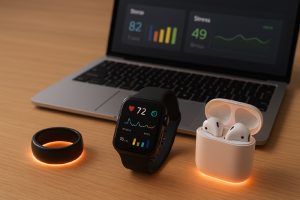Not long ago, self-care meant a yoga class, a scented candle, or a few extra hours of sleep. Today, it might also mean checking your heart rate variability, tracking your stress levels with a wearable, or letting an AI app nudge you toward better habits. Welcome to the new era of wellness tech—where biometric data and artificial intelligence are turning self-care into something smarter, more personalized, and surprisingly effortless.
From rings that monitor your sleep cycles to apps that predict burnout before you feel it, technology is no longer just helping us do more—it’s helping us feel better. In this post, we’ll explore how these tools are reshaping the way we care for ourselves, and what it means for the future of wellbeing.

Self-care used to mean bubble baths, spa days, or maybe a yoga class. Those are still wonderful, but the definition of wellness has changed. In 2025, self-care is getting smarter, more personalized, and powered by technology.
From wearable rings that monitor your sleep cycles to AI apps that suggest meditation when your stress spikes, wellness tech is reshaping how we look after ourselves. It’s no longer just about relaxation—it’s about using data and artificial intelligence to create routines that truly fit our bodies, minds, and lifestyles.
So, let’s explore how biometric and AI tools are transforming self-care—and whether this shift is as promising as it sounds.
What Exactly Is Wellness Tech?
At its simplest, wellness tech refers to gadgets, apps, and platforms designed to improve health and wellbeing. Unlike traditional medical devices, these tools often sit in the consumer space—meaning they’re designed for everyday people, not just doctors or hospitals.
Two big drivers are leading the change:
- Biometrics – Data about your body, like heart rate, sleep patterns, steps, and even stress levels.
- Artificial Intelligence (AI) – Algorithms that analyse this data to offer insights, predictions, and recommendations.
Put them together, and you’ve got tech that doesn’t just track what’s happening, but also guides you toward better choices.
From Step Counters to Full-Body Insights
Remember when the hottest wearable feature was a simple step counter? Those days are long gone. Today’s devices are practically mini health labs on your wrist (or finger, or even in your earbuds).
Popular wellness gadgets now measure:
- Sleep stages (deep, REM, light) and recovery.
- Heart rate variability (HRV)—an indicator of stress and resilience.
- Blood oxygen levels, useful for altitude, fitness, and sleep quality.
- Skin temperature changes, which can even hint at illness onset.
- Menstrual cycle tracking, supported by biometric data for accuracy.
The difference isn’t just in measurement. Thanks to AI, these devices can interpret the data and suggest what to do. For example, if your HRV is unusually low, your smartwatch might recommend skipping high-intensity exercise in favour of a restorative yoga session.
AI as Your Wellness Coach
AI is quickly becoming the personal coach many of us didn’t know we needed. Instead of offering one-size-fits-all advice, wellness apps powered by AI can tailor recommendations to your unique patterns.
Here are a few ways AI is stepping into the role of coach:
- Personalized Fitness Plans – Apps like Whoop and Oura combine biometric data with AI to design recovery-based workouts.
- Meditation & Stress Support – AI-driven mindfulness apps suggest guided meditations based on stress signals from wearables.
- Nutrition Guidance – Some platforms analyse activity, sleep, and even glucose data to recommend meals that stabilize energy.
- Predictive Health Alerts – Early-warning systems flag signs of burnout, fatigue, or illness before you notice them.
This kind of real-time coaching brings self-care into daily life, making it less about waiting for a “reset weekend” and more about micro-adjustments throughout the week.
Everyday Examples of Wellness Tech in Action
Let’s imagine a typical morning in 2025 powered by wellness tech:
- Wake Up – Your sleep tracker gently wakes you during light sleep, not with a blaring alarm.
- Morning Scan – Your smartwatch shows a recovery score, suggesting a light run instead of a heavy workout.
- Mindfulness Moment – An app notices your heart rate is elevated and nudges you to breathe deeply for two minutes before your first meeting.
- Nutrition Nudge – Based on your glucose monitor and activity, an AI app recommends a protein-rich breakfast.
- Evening Wind-Down – Blue-light sensors in your home suggest dimming lights earlier, promoting better sleep.
The goal isn’t to overwhelm you with alerts—it’s to make wellness seamless, integrated into your daily flow.
The Benefits of Biometric & AI Self-Care
Why is this shift so exciting? Here are some standout benefits:
- Personalization – No more generic wellness plans. Your data shapes your care.
- Prevention – Subtle changes (like rising stress levels) can be caught early.
- Motivation – Real-time feedback makes healthy habits more rewarding.
- Accessibility – Many tools fit on your wrist or phone, putting insights in everyone’s pocket.
- Consistency – Micro-nudges throughout the day make wellness more sustainable than big, occasional resets.
For many people, these advantages make wellness more approachable and effective than ever.
The Challenges & Concerns
Of course, wellness tech isn’t all glowing green lights. There are some important concerns to keep in mind:
- Data Privacy – Your health information is sensitive. Who owns it, and how is it used?
- Over-Reliance – If we rely too much on gadgets, we might forget to tune into our own bodies.
- Accuracy – While getting better, consumer devices aren’t perfect. Readings should guide, not dictate.
- Cost – Many top-tier wearables and apps aren’t cheap, which can make access unequal.
- Wellness Anxiety – Constant tracking may stress some people out instead of helping.
Being aware of these challenges helps us use wellness tech mindfully, as a tool—not as a replacement for intuition or professional care.
The Future of Wellness Tech
Where is all this headed? Experts predict a few big shifts in the next five years:
- More Integrated Devices – Imagine one wearable that seamlessly monitors sleep, fitness, stress, and nutrition.
- AI Companions – Virtual assistants that act as emotional and physical wellness coaches.
- Preventive Medicine – Data from wellness wearables may inform healthcare providers, blurring lines between lifestyle and clinical care.
- Hyper-Personalization – AI tailoring recommendations to genetics, environment, and daily habits.
- Seamless Environments – Smart homes adjusting lighting, temperature, and even scent based on biometric cues.
The vision is a world where technology quietly supports wellbeing in the background, freeing us to live more fully.
Final Thoughts: Tech + Humanity = Smarter Self-Care
Wellness tech is transforming self-care from a once-in-a-while treat into a daily practice grounded in data and guided by AI. It’s helping us sleep better, move smarter, eat well, and stress less—all while adapting to our personal rhythms.
But as exciting as the gadgets are, it’s worth remembering that self-care is still about you. A wearable can tell you to rest, but only you can decide to slow down. An app can suggest meditation, but only you can sit quietly and breathe.
Used wisely, biometric and AI tools aren’t replacing traditional self-care—they’re enhancing it, making it more precise, personalized, and practical for busy modern lives.
The future of self-care? A partnership: your intuition + technology’s insights. Together, they just might create the healthiest version of you yet.


